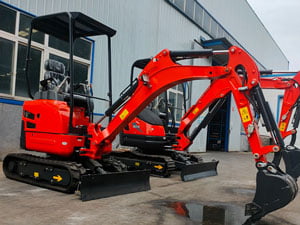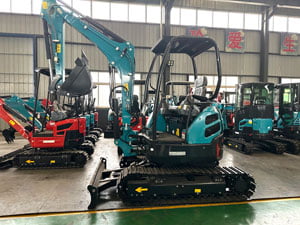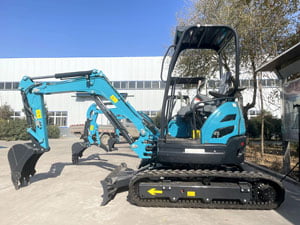Bienvenido a mi blog
Estoy encantada de tenerte aquí. Antes de sumergirnos en el contenido, me encantaría que te unieras a mí en mis plataformas de medios sociales. En ellas comparto mis ideas, me relaciono con una comunidad increíble y te mantengo al día de las últimas novedades. Aquí tienes cómo mantenerte conectado:
📘 Facebook: Conéctate conmigo en Facebook
🔗 LinkedIn: Sígame en LinkedIn
▶️ YouTube: Canal de fabricantes de tractores,Canal de fabricantes de excavadoras
🎥 TikTok: Fabricante de tractores,Fabricante de excavadoras
Emprendamos juntos este viaje. Espero que encuentres el contenido interesante, atractivo y, lo más importante, valioso. Exploremos, aprendamos y crezcamos.
Índice
Introducción
When it comes to construction and excavation tasks, the backhoe mini excavator has become an essential piece of equipment. Choosing the right one is critical to ensuring that the job gets done efficiently and within budget. However, buying a backhoe mini excavator is not a simple decision. There are several factors to consider that will influence the performance, cost, and usability of the machine. In this blog post, we will discuss the three key factors you need to consider before purchasing a backhoe mini excavator.
1. Size and Maneuverability of the Backhoe Mini Excavator
One of the primary considerations when choosing a backhoe mini excavator is its size and maneuverability. Unlike larger excavators, mini excavators are designed for tighter spaces and more confined work environments. However, within the category of mini excavators, there is still a wide range of sizes to choose from.
Understanding the Scope of Your Project
Before deciding on the size of your machine, evaluate the worksite where you’ll be using the equipment. For smaller residential jobs or projects that involve tight spaces, a mini excavator with a reduced width and compact design will be ideal. On the other hand, if you’re working in more open areas, a slightly larger model may provide the additional power and capabilities you require.
Tight Spaces vs. Open Areas
Mini excavators are ideal for working in narrow spaces where larger machinery would be impractical. Their compact design allows for easy access through gates, alleyways, and around obstacles such as buildings or trees. If your project requires working around structures, fences, or inside buildings, you may need to opt for a mini excavator with a smaller turning radius and reduced overall width.
Conversely, when working in open fields or large construction sites, a larger mini excavator will allow for more substantial work output. Consider the type of environment and the level of access required before making your final decision.
Weight and Transport Considerations
The weight of your backhoe mini excavator will also affect its maneuverability and transportability. Lighter models are easier to transport between job sites and can be hauled by smaller trucks. However, a heavier mini excavator may be necessary if you require more lifting capacity or digging depth. Consider how often you’ll need to move the equipment between locations and whether the machine’s weight is manageable.
2. Engine Power and Performance of the Backhoe Mini Excavator


The engine power of your backhoe mini excavator will significantly impact its performance. Different projects require different levels of power, so understanding the engine specifications is crucial to choosing the right model. Engine power, typically measured in horsepower (HP), determines the machine’s lifting capacity, digging depth, and overall efficiency.
Assessing Engine Power Needs for Your Tasks
In general, if you are involved in light-duty tasks such as landscaping, small trenching, or digging in loose soil, a mini excavator with a lower engine power may be sufficient. For example, machines with engines that produce between 20 and 40 HP are suitable for these types of jobs.
For more demanding tasks, such as excavation in rocky soil or heavy-duty trenching, you may need a more powerful backhoe mini excavator with an engine in the 50-75 HP range. Stronger engines provide greater digging depth, increased lifting capacity, and enhanced digging force, which are essential for large-scale excavation or landscaping projects.
Fuel Efficiency vs. Power Consumption
While higher engine power offers better performance, it comes at the cost of increased fuel consumption. Choosing the right balance between engine power and fuel efficiency is critical for controlling operating costs. Machines with more powerful engines consume more fuel but can complete tasks faster, reducing project time. Conversely, machines with smaller engines may be more fuel-efficient but take longer to complete the same tasks.
It’s also worth noting that higher engine power may result in higher maintenance costs over time. More powerful machines generally experience more wear and tear, which can increase the frequency of repairs. Assess your project’s timeline and budget to determine whether investing in a more powerful engine is worth the additional cost.
Hydraulic Power and System Efficiency
Another key aspect of engine power to consider is the hydraulic system. Many mini excavators rely heavily on hydraulic systems to operate the backhoe and other attachments. The power of the hydraulic system is directly related to the overall efficiency of the machine. A more powerful hydraulic system can provide better lifting capabilities and faster performance.
Al seleccionar un backhoe mini excavator, ensure that the hydraulic system is designed to handle the load and performance requirements of your tasks. Stronger hydraulic systems also tend to last longer and require less frequent maintenance.
3. Versatility and Attachments for the Backhoe Mini Excavator


The versatility of a backhoe mini excavator is another critical factor to consider. These machines are often used for a wide range of tasks beyond simple digging, and the ability to use various attachments can significantly increase the machine’s functionality. Therefore, it’s essential to assess which attachments are available for the machine and whether they suit your needs.
Popular Attachments for Backhoe Mini Excavators
Mini excavators can be outfitted with a variety of attachments to tackle different types of work. Some of the most popular attachments include:
- Cubos: For digging, scooping, and lifting materials. Various bucket sizes are available depending on the type of material you’re working with.
- Martillos hidráulicos: Ideal for breaking rock, concrete, or asphalt. These attachments are commonly used in demolition work.
- Sinfines: Used for drilling holes in the ground, which is useful for fence posts, tree planting, or utility installations.
- Tilt-rotators: Allow the operator to rotate and tilt the bucket or attachment for more precise control.
- Pinzas: Useful for handling large, irregularly shaped materials such as logs or construction debris.
Before purchasing a backhoe mini excavator, make sure the machine is compatible with the attachments you need for your projects. Some machines come with a universal attachment system, while others require specialized adapters.
Attachment Versatility and Job Site Requirements
Your choice of attachments will depend on the specific tasks required on your job site. For example, if your work involves digging trenches, a bucket attachment may be the most useful. However, if you plan to perform demolition or heavy lifting, you might need a hydraulic hammer or grapple.
Having access to a wide range of attachments allows you to use your backhoe mini excavator for a variety of tasks, which makes the equipment more versatile and cost-effective in the long run. A versatile mini excavator will enable you to complete multiple types of work without needing to invest in additional machinery.
Ensuring Compatibility with Your Current Tools
If you already own certain attachments for other machines, check if the backhoe mini excavator you are considering can accommodate them. This can save you money by allowing you to use the attachments you already own. Compatibility with your existing tools will also streamline your operations and reduce downtime on the job site.
Performance Comparison Table
| Característica | Small Backhoe Mini Excavator | Large Backhoe Mini Excavator |
|---|---|---|
| Potencia del motor | 20-40 HP | 50-75 HP |
| Profundidad de excavación | Up to 10 feet | Up to 15 feet |
| Maximum Lift Capacity | 2000 lbs | 5000 lbs |
| Machine Weight | 3-4 tons | 6-8 tons |
| Eficiencia de combustible | Higher fuel consumption | Moderate fuel consumption |
| Anexos disponibles | Basic attachments | Wide range of attachments |
Conclusión
In conclusion, buying the right backhoe mini excavator requires careful consideration of factors such as size, engine power, and versatility. By choosing the right machine based on these factors, you can ensure that your investment is well-suited for your project needs. Assess the specific requirements of your site and tasks before making a final decision, and make sure to select a machine that can handle your workload effectively and efficiently. With the right backhoe mini excavator, you’ll be well-equipped to tackle a variety of excavation and construction challenges with ease.
PREGUNTAS FRECUENTES
What is the best backhoe mini excavator for tight spaces?
A smaller backhoe mini excavator with reduced width and compact design is ideal for tight spaces. Consider models with a narrow track or wheel configuration for better maneuverability.
How do I determine the right engine power for my backhoe mini excavator?
The engine power should be selected based on the type of work you plan to do. For general digging and landscaping, a machine with a lower engine power (around 20-40 HP) will be sufficient, while heavy-duty tasks will require higher engine power (50-75 HP).
Can I use attachments with a backhoe mini excavator?
Yes, many backhoe mini excavators are designed to work with a variety of attachments, such as buckets, augers, and hydraulic hammers, making them more versatile for different tasks.
Son backhoe mini excavators ¿Combustible eficiente?
Backhoe mini excavators are generally fuel-efficient, especially the smaller models. However, more powerful machines may consume more fuel, so it is essential to balance power with fuel efficiency based on your work requirements.




